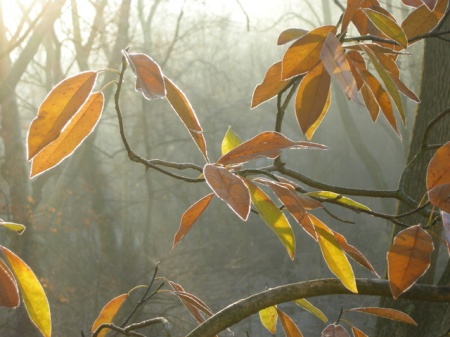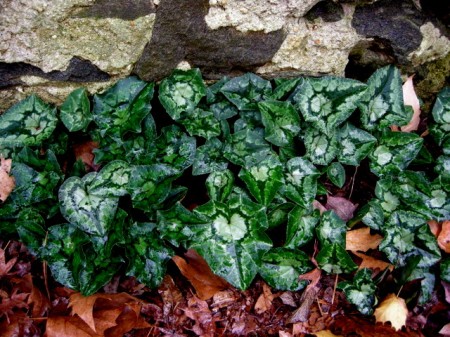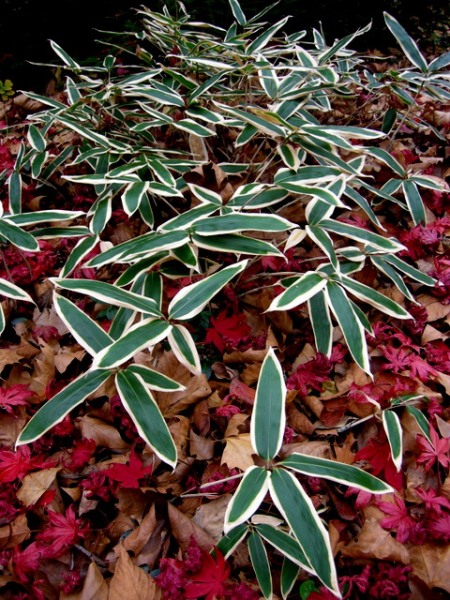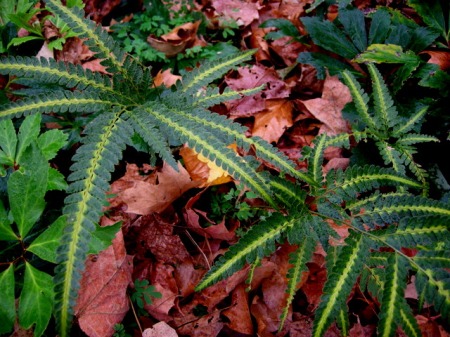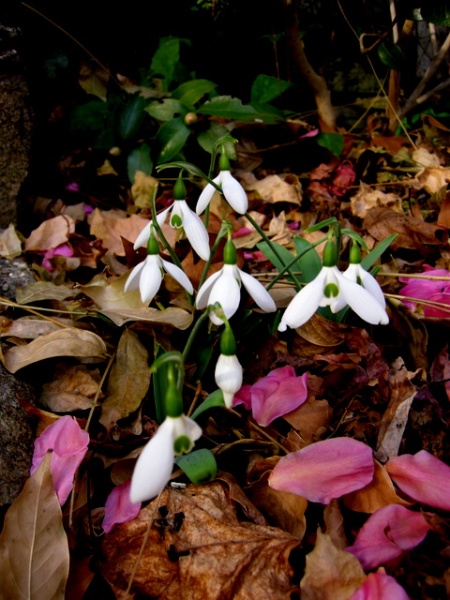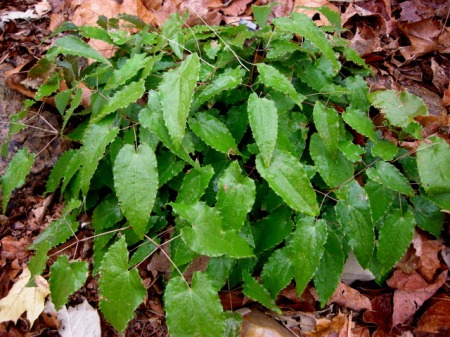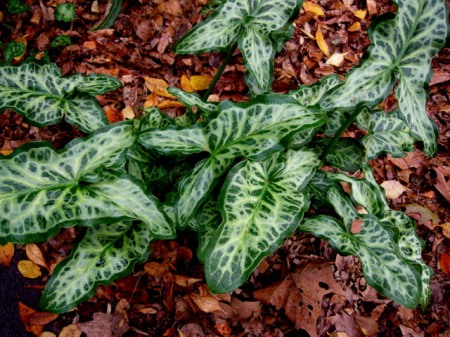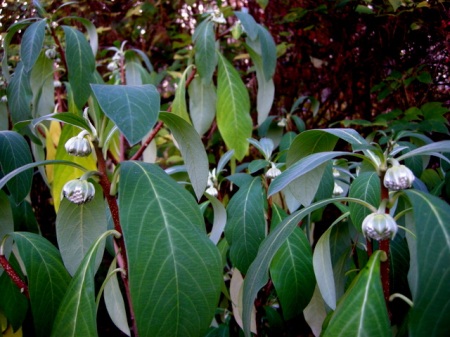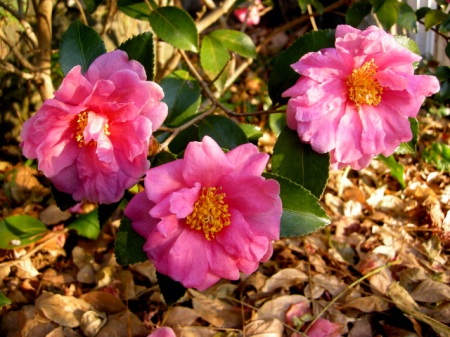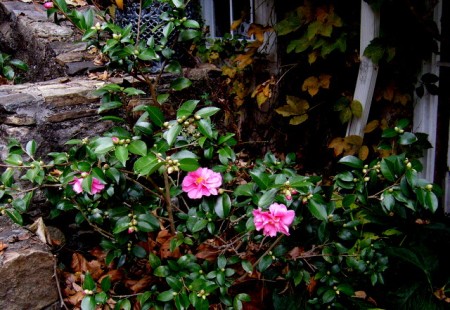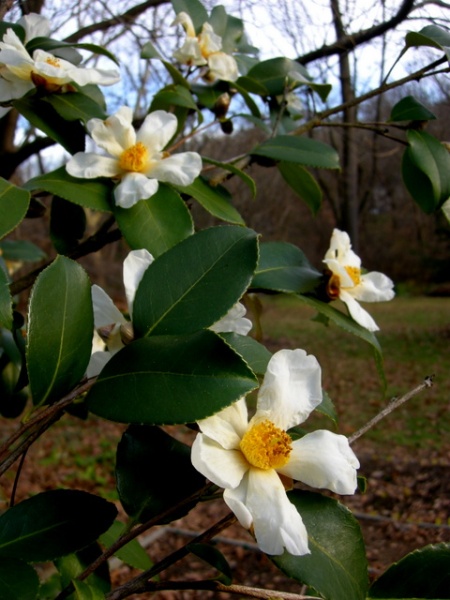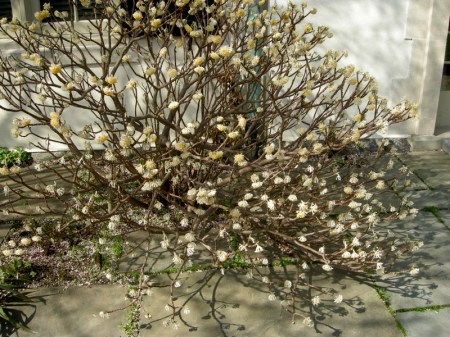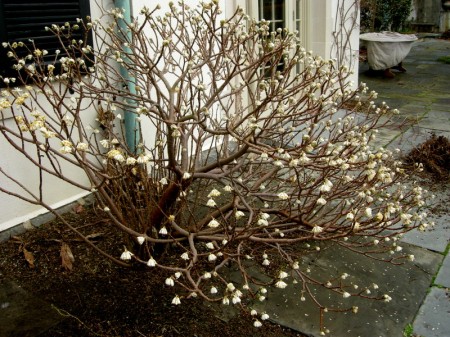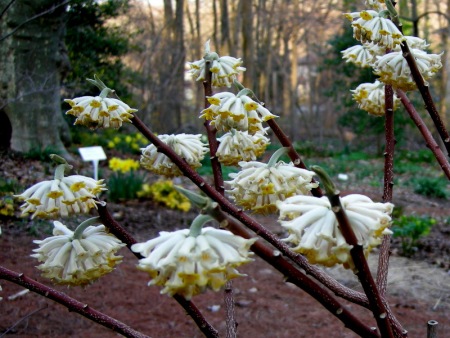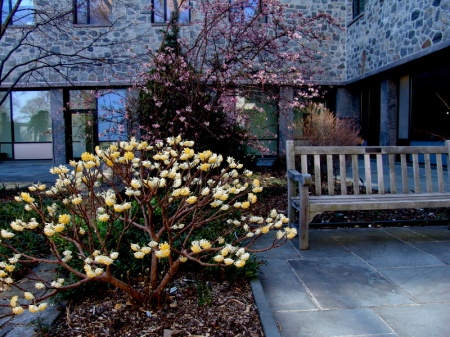Carolyn’s Shade Gardens is a retail nursery located in Bryn Mawr, PA, specializing in showy, colorful, and unusual plants for shade. The only plants that we ship are snowdrops and miniature hostas. For catalogues and announcements of events, please send your full name, location, and phone number (for back up use only) to carolyn@carolynsshadegardens.com. Click here to get to the home page of our website for catalogues and information about our nursery and to subscribe to our blog.
 Ashe magnolia is a rare native bigleaf magnolia in a size suitable for almost any garden.
Ashe magnolia is a rare native bigleaf magnolia in a size suitable for almost any garden.
.
Because shade gardens are not composed solely of perennials, three times a year I offer woody plants—shrubs, trees, and vines—to my customers. I want them to have a reliable source for large and healthy specimens, but I also want to make available woody plants for shade that are wonderful but hard-to-find. I am in the middle of an offer right now, and customers need to let me know if they want to order by Sunday, September 29. To see the 2013 Fall Shrub Offer, click here.
When I do these offers, I also do a post describing the plants in more detail. These posts are some of the most popular I have ever written. In fact, Woody Plants for Shade Part 2 is number four for all time views and Woody Plants for Shade Part 1 is number eight. If you want to read about all the plants I have recommended, you can find the remaining six by using the Search My Website feature on the right hand side of the home page. So let’s get to the plants that I am recommending this time, starting with the trees.
.
 This is my own Ashe magnolia, which I planted in an open, north-facing bed. It bloomed after its first full year and was spectacular as promised.
This is my own Ashe magnolia, which I planted in an open, north-facing bed. It bloomed after its first full year and was spectacular as promised.
.
I have been coveting the native bigleaf magnolia, also known as the large-leaved cucumber tree, M. macrophylla, for a long time. It has gorgeous, gigantic fragrant flowers and the most amazing leaves and did I say it was native? There is even one in my neighborhood for me to lust after. However, it’s huge, the sources say 40 feet tall by 40 feet wide, but I have seen larger specimens. Plantsman Michael Dirr calls it a “cumbersome giant”, and it takes forever to bloom. Imagine how excited I was when I discovered a small version of this tree tucked into a courtyard at Chanticleer.
.
 The flower bud on the Ashe magnolia.
The flower bud on the Ashe magnolia.
.
Ashe magnolia, M. macrophylla ssp. ashei, is a subspecies of the bigleaf magnolia, or maybe it is its own species, but the important thing is that it only grows to 15 to 20 feet tall with a similar width. The specimen at the Scott Arboretum is 10 feet tall after 20 years. It has the same spectacular, tropical-looking 24″ leaves. The huge 10″, highly fragrant flowers are pure white with a purple center spot and bloom in early summer. Unlike its big relative, it blooms at a very young age in sun to part shade. It originates in the Florida panhandle and its hardiness range is unclear. However, it does fine in the Delaware Valley.
.
 Korean stewartia has attractive exfoliating bark that is especially ornamental in winter.
Korean stewartia has attractive exfoliating bark that is especially ornamental in winter.
.
 Stewartias are known for their striking fall color.
Stewartias are known for their striking fall color.
.
 Korean stewartia blooms in the summer with white, camellia-like flowers.
Korean stewartia blooms in the summer with white, camellia-like flowers.
.
Korean stewartia, S. koreana, is another small tree that is easily integrated into home gardens. It reaches 25 feet in height and has an upright, pyramidal shape. Its large, white, camellia-like flowers appear over a long period of time in June and July. Its cinnamon-colored, exfoliating bark is visually interesting in winter. The refined dark green leaves turn a beautiful orange-red color in fall. Korean stewartia has received the coveted Pennsylvania Horticultural Society Gold Medal Plant award. For details, click here. This is an elegant tree for the smaller landscape with a solid 365 days of ornamental interest.
.
 Fall-blooming hardy camellia ‘Long Island Pink’
Fall-blooming hardy camellia ‘Long Island Pink’
.
Fall-blooming camellias hardy in zone 6, the zone for most of southeastern Pennsylvania, are hard to find for sale especially in a decent size. Even though hardy camellias suitable for our more northern climate were developed over 20 years ago, they are not well known to most gardeners and even to the horticultural trade. That is why I always include a nice selection in my offering. For more information on them generally, you can read my posts by clicking here, which will take you to Part 4 in the series and provide links to the first three parts. To summarize, they bloom in part to full shade in the fall, generally from October through December, with large showy flowers and have glossy evergreen leaves and a lovely habit.
.
 ‘Northern Exposure’ fall-blooming camellia
‘Northern Exposure’ fall-blooming camellia
.
I am offering three camellias this time. ‘Long Island Pink’ has a compact and upright habit reaching 5 feet tall and three feet wide. It produces lovely single pink flowers in mid-fall and has glossy dark evergreen leaves. ‘Northern Exposure’ grows to 6 feet tall and five feet wide. Its pale pink buds open to very large, single white flowers with bright yellow stamens over a long period of time in fall. The flowers look gorgeous against the glossy dark evergreen leaves.
.
 ‘Winter’s Dream’ fall-blooming camellia
‘Winter’s Dream’ fall-blooming camellia
.
‘Winter’s Dream’ also has a compact and upright habit, reaching 8 feet tall and 5 feet wide. It produces very showy semi-double pink flowers in early fall. ‘Winter’s Dream’ was developed by famous camellia breeder Dr. William Ackerman at the U.S. National Arboretum. All three of these camellias are fully cold hardy in our area but benefit from siting to protect them from winter sun and wind, which generally comes from the northwest.
.
 The berries of our native American beautyberry are eye-catching to say the least.
The berries of our native American beautyberry are eye-catching to say the least.
.
I always try to plant native trees and shrubs when I can for many reasons ranging from their durability and beauty to the ultimate survival of the human species (for more on this read My Thanksgiving Oak Forest). So you can imagine how happy I was to find a source for native American beautyberry, Callicarpa americana. I immediately planted three of them on the shady open hillside above my nursery and have been very impressed with the spectacular berries they produced this fall.
American beautyberry grows 6 feet tall and 5 feet wide in sun to part shade. Its pink flowers in early summer are nice, but, like all beautyberries, it takes center stage in fall. Right now large clusters of spectacular, long-lasting, magenta-purple berries march up and down the branches wherever the leaves join the stem. The color is so unusual it stops people in their tracks. This striking native plant is also deer resistant and attractive to birds. I am thrilled to be able to offer this wonderful native to my customers.
.
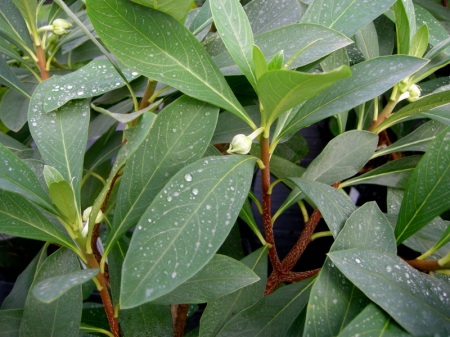 Right now edgeworthia is just forming its gorgeous silver buds, which remain ornamental all winter.
Right now edgeworthia is just forming its gorgeous silver buds, which remain ornamental all winter.
.
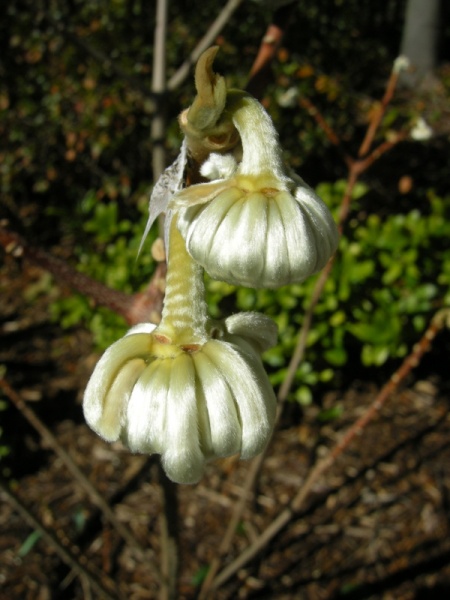 The whole bush is loaded with these buds all fall and early winter before the flowers open.
The whole bush is loaded with these buds all fall and early winter before the flowers open.
.
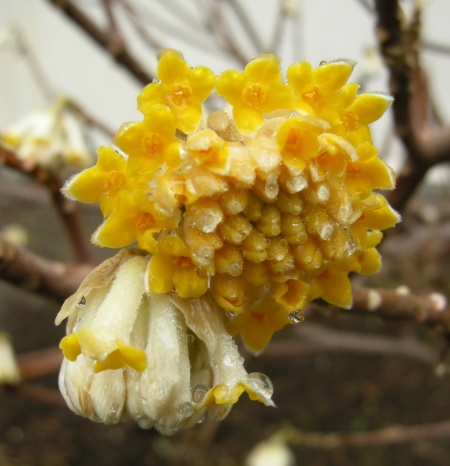 Edgeworthia’s fragrant and unusual yellow flowers are very long-blooming.
Edgeworthia’s fragrant and unusual yellow flowers are very long-blooming.
.
I have profiled Edgeworthia chrysantha (supposedly called paper bush but everyone calls it edgeworthia) before in my woody plants for shade series and written a post on what is one of my top five favorite shrubs. For all the details, see Edgeworthia, A Shrub for All Seasons. I continue to offer it again and again because it is very hard to find for sale. I am not sure why because it is ornamental 365 days a year with an elegant habit, reddish bark, large tropically-textured leaves, gorgeous silver buds from fall to late winter, and fragrant flowers from January to March. For all the details, including a discussion of edgeworthia’s cultural requirements, you will have to read my post.
.
 ‘Incrediball’ smooth hydrangea in my garden.
‘Incrediball’ smooth hydrangea in my garden.
.
 The flowers of ‘Incrediball’ are gorgeous in both their white and green stages. They last forever in a vase.
The flowers of ‘Incrediball’ are gorgeous in both their white and green stages. They last forever in a vase.
.
Another native, ‘Incrediball’ smooth hydrangea, H. arborescens, grows to 5 feet tall and 4 feet wide in part shade and is full shade tolerant. Its very showy pure white, 12″ and larger globular flowers are set off beautifully by smooth bright green leaves from June through August. Unlike some other hydrangeas whose flowers turn brown, these flowers age to a lovely green and are wonderful in dried arrangements. ‘Incrediball’ is a vast improvement on ‘Annabelle’ because it has very sturdy upright stems and its flowers do not flop even in the torrential rains we had early this summer. My one-year-old plants shown above were loaded with upright flowers all summer. Smooth hydrangea is said to be deer resistant and mine, which are exposed to deer, have not been touched.
.
 The leaves and flowers of ‘Forever Pink’ are both beautiful.
The leaves and flowers of ‘Forever Pink’ are both beautiful..
I chose ‘Forever Pink’ bigleaf hydrangea, H. macrophylla, for the offer because its leaves still look beautiful in the fall and it has striking flowers. It grows to 3 feet tall and 5 feet wide in sun to full shade. The vibrant, large, dark pink flowers cover the plant for an extended period in summer. It has a compact, globe-shaped form with thick stems that resist falling over. ‘Forever Pink’ is very tolerant of cold temperatures and salt and can take more sun than other bigleaf hydrangeas due to its thick leaves.
.
 ‘Pee Wee’ oakleaf hydrangea is small enough to fit almost anywhere in the garden.
‘Pee Wee’ oakleaf hydrangea is small enough to fit almost anywhere in the garden.
.
 All oakleaf hydrangeas have lovely red to burgundy fall color.
All oakleaf hydrangeas have lovely red to burgundy fall color.
.
 Oakleaf hydrangea’s large flowers
Oakleaf hydrangea’s large flowers
.
Everyone should have a native oakleaf hydrangea in their garden for four-season interest. They get quite large, but ‘Pee Wee’ dwarf oakleaf hydrangea, H. quercifolia, is the perfect cultivar for smaller gardens and smaller spaces. It grows to 4 feet tall and 4 feet wide in full sun to full shade. The large, long-lasting, upright pyramids of white flowers in June and July change to pink as they age and even look good brown. The bold-textured leaves with burgundy-red fall color and cinnamon-colored exfoliating bark move the season of interest through fall and winter. Oakleaf hydrangeas are walnut tolerant and native to the southeastern US.
.
 The berries of ‘Amethyst’ coral berry cover the shrub.
The berries of ‘Amethyst’ coral berry cover the shrub.
.
I was looking through my supplier’s availability list when I came across native ‘Amethyst’ coral berry, Symphoricarpos x doorenbosii, a shrub unknown to me. I was very excited when I discovered that it is a hybrid of two Pennsylvania natives and thrives in the shade. ‘Amethyst’ grows to 3 to 5 feet tall with a similar width in part shade, but is full shade tolerant. Small pink flowers appear in June. In the fall, abundant and unusually striking pink fruit are set off beautifully by fine-textured blue-green leaves and then remain after the leaves drop. Coral berry is deer resistant and attractive to birds.
.
I hope I have introduced you to some new trees and shrubs that excite you. Remember orders must be received by September 29.
Carolyn
.
Carolyn’s Shade Gardens is a retail nursery located in Bryn Mawr, Pennsylvania, U.S., zone 6b. The only plants that we mail order are snowdrops and miniature hostas and only within the US.
If you are within visiting distance and would like to receive catalogues and information about customer events, please send your full name and phone number to carolynsshadegardens@verizon.net. Subscribing to my blog does not sign you up to receive this information.
Nursery Happenings: Carolyn’s Shade Gardens will hold a full-fledged open house sale on Saturday, September 28, from 10 am to 3 pm. Shrub and tree orders are due by September 29. For details, click here. We are currently offering double hellebores, both by pre-order and at the nursery. For details, click here. Now that it’s cool, we are also shipping miniature hostas again. For details, click here. Low maintenance seminars are in the works.
Facebook: Carolyn’s Shade Gardens has a Facebook Page where I post single photos, garden tips, and other information that doesn’t fit into a blog post. You can look at my Facebook page here or click the Like button on my right sidebar here.
Notes: Every word that appears in orange on my blog is a link that you can click for more information. If you want to return to my blog’s homepage to access the sidebar information (catalogues, previous articles, etc.) or to subscribe to my blog, just click here.
 The fragrant, rose-pink double flowers of ‘Peggy Clarke’ flowering apricot, Prunus mume, have been a sensation at Carolyn’s Shade Gardens since early March.
The fragrant, rose-pink double flowers of ‘Peggy Clarke’ flowering apricot, Prunus mume, have been a sensation at Carolyn’s Shade Gardens since early March. ‘Peggy Clarke’ is a gorgeous small tree with a vased-shaped habit, sited here in a west-facing location near our front door for optimal late-winter viewing.
‘Peggy Clarke’ is a gorgeous small tree with a vased-shaped habit, sited here in a west-facing location near our front door for optimal late-winter viewing. Winter jasmine, Jasminum nudiflorum, cascades off the corner of our terrace, but I have also seen it grown as a groundcover. It normally opens a few flowers during warm days in January and February; however, we have had such a mild winter that it has been flowering for about five months. The photo shows the last few blooms as the leaves start to open.
Winter jasmine, Jasminum nudiflorum, cascades off the corner of our terrace, but I have also seen it grown as a groundcover. It normally opens a few flowers during warm days in January and February; however, we have had such a mild winter that it has been flowering for about five months. The photo shows the last few blooms as the leaves start to open. Our star magnolia, M. stellata, is often damaged by frost, but I wouldn’t be without its glorious masses of early, pure white flowers.
Our star magnolia, M. stellata, is often damaged by frost, but I wouldn’t be without its glorious masses of early, pure white flowers. We have planted a field of blue glory-of-the-snow, Chionodoxa forbesii, under the star magnolia, and the combination is beautiful. I couldn’t get a satisfactory shot of the two together, but you can see the magnolia trunk in the background.
We have planted a field of blue glory-of-the-snow, Chionodoxa forbesii, under the star magnolia, and the combination is beautiful. I couldn’t get a satisfactory shot of the two together, but you can see the magnolia trunk in the background. Another shrub that has been blooming off and on since late fall is evergreen Japanese mahonia, M. japonica. This mahonia is the best species for garden use as its leaves remain pristine and its flowers are a lovely shade of yellow in large sprays.
Another shrub that has been blooming off and on since late fall is evergreen Japanese mahonia, M. japonica. This mahonia is the best species for garden use as its leaves remain pristine and its flowers are a lovely shade of yellow in large sprays. If Cornelian cherry dogwood, Cornus mas, bloomed later in the season, it would be overshadowed by many other small flowering trees. However, its fresh, yellow-green flowers stand out in the stark late winter landscape.
If Cornelian cherry dogwood, Cornus mas, bloomed later in the season, it would be overshadowed by many other small flowering trees. However, its fresh, yellow-green flowers stand out in the stark late winter landscape. ‘Okame’ cherry, Prunus x incam ‘Okame’, viewed here from an upstairs window, provides shade for our deck and is the earliest blooming cherry with very long-lasting flowers.
‘Okame’ cherry, Prunus x incam ‘Okame’, viewed here from an upstairs window, provides shade for our deck and is the earliest blooming cherry with very long-lasting flowers. Under the ‘Okame’ cherry, by the edge of the deck is a dwarf Japanese maple, Acer palmatum ‘Yatsubusa Kiyohime’. Its leaves come out very early and are a striking combination of red and bronze.
Under the ‘Okame’ cherry, by the edge of the deck is a dwarf Japanese maple, Acer palmatum ‘Yatsubusa Kiyohime’. Its leaves come out very early and are a striking combination of red and bronze. Our edgeworthia opens its fragrant yellow and white flowers in late winter. This shrub has four seasons of ornamental interest with beautiful flowers, cinnamon-colored bark, tropical leaves, and, my favorite, copious silver buds like tassels on Victorian cushions starting in November.
Our edgeworthia opens its fragrant yellow and white flowers in late winter. This shrub has four seasons of ornamental interest with beautiful flowers, cinnamon-colored bark, tropical leaves, and, my favorite, copious silver buds like tassels on Victorian cushions starting in November. Yulan magnolia, M. denudata, is a relatively rare, early-blooming magnolia with large, goblet-like white flowers. Again, it can get damaged by late frosts but is well worth having in the years like this one when it is magnificent.
Yulan magnolia, M. denudata, is a relatively rare, early-blooming magnolia with large, goblet-like white flowers. Again, it can get damaged by late frosts but is well worth having in the years like this one when it is magnificent. Buttercup winter hazel, Corylopsis pauciflora, is an early-blooming, fine-textured shrub with elegant, butter yellow flowers.
Buttercup winter hazel, Corylopsis pauciflora, is an early-blooming, fine-textured shrub with elegant, butter yellow flowers. ‘Texas Scarlet’ dwarf flowering quince gives an eye-catching punch of color in what can still be a dreary winter landscape. It stays quite small and doesn’t have thorns like regular quinces.
‘Texas Scarlet’ dwarf flowering quince gives an eye-catching punch of color in what can still be a dreary winter landscape. It stays quite small and doesn’t have thorns like regular quinces.
































